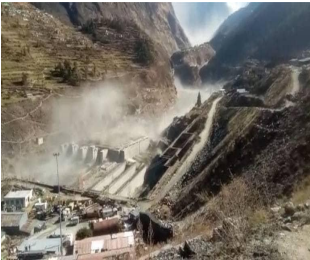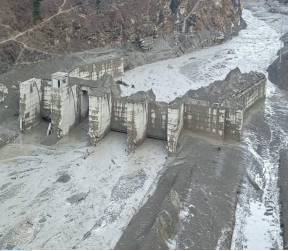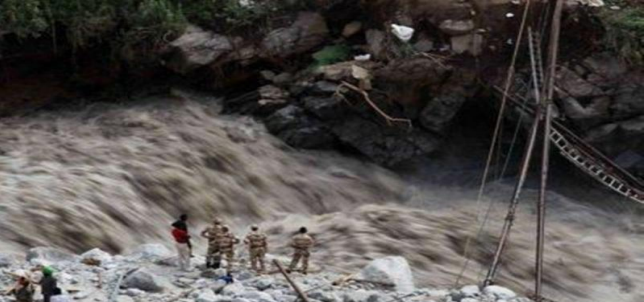Early Warning Dissemination System
Early Warning dissemination systems (EWS) are central to limiting the loss of lives and livelihoods as a result of hazards, disasters and military operations. It is a series of orgranized surveillance mechanisms or actions that collect information on potential hazards in a given location, in order to trigger timely, coordinated responses. Early warning systems build resilience to disasters and thus mitigate their impact. This is clearly recognized in the Sendai Framework for Disasters Risk Reduction 2015-2030, whose seventh global target is substantially increase the availability of and access to multi-hazard early warning systems and disaster risk information and assessments to people by 2030. Member countries including India is thus committed to making early warning systems more people-centered, and also to improving access to risk information for end users. In disaster risk management, this will mean combining scientific information with practical approaches.
The EWS project is basically for designing, engineering, manufacturing, supply, installation & commissioning of Alert, Inform and Direct System (AI&D System) for before the release of water from dam of a Power House, during heavy rainfall or military opeartions through Phone, E-mail, SMS and Siren systems.
- This project is AI&D System with Pre Alarm System which helps to alert and guide the people living nearby river banks when the water is released from Dam.
- This project consists of AI&D system, several sequences of PA (Public announcement) System in different languages, Strobe Light/Siren, GSM, Level Sensor, RTU, SCADA, Alarm Annunciator, Loud Speaker and Amplifier to complete the project.
- An Early Warning System (EWS) can be defined as set of capacities needed to generate and disseminate timely and meaningful warning information of the possible extreme or disasters (e.g. floods, droughts, fire, earthquakes and tsunamis) that threatens people's lives.
- The very purpose of this information is to enable individuals, communites and organizations which are threatened, to prepare and act appropriately in due sufficient time to reduce the possibility of harm, loss and risk.



Early Warning Systems Have the Following Four Components:
Risk knowledge: Data should be systematically collected and analyzed and risk assessment performed.
Monitoring and Warning Service: Systems should be in place to monitor hazards and provide early warning services.
Dissemination and Communication: Risk information and early warning messages must be delivered.
Response capability: Systems should be in place to respond to events.
Software Features
- Dual feature of control –remotely from control room and also locally at the Siren controller box for an authorized user.
- Operation Trends.
- Emergency push button to play the prerecorded messages, present at each local station.
- Message, siren/hooter or live option for playing prerecorded voice messages.
- Loggings of events at Dam Control Room.
- Health status of all Hooters/Siren can be checked Located at Dam Control Room through graphics based software
- Manual control for operation of Hooter in case of failure of communication from Dam control room or any other control center.
- Siren in Silent mode testing at remote location.
- Feedback of Siren Locations.
Applications
- Natural disasters such as floods, cyclones or tsunamis etc. where it is not advised to go out.
- Alerting the citizens or tourists during flash floods or before opening of dam gates.
- In Defence and Military for central communication purpose and alerting the defence personals.
Advantages of Early Warning System:
The main purpose of flood warning is to save life by allowing people, to provide support and emergency services time to prepare for flooding. The secondary purpose is to check mitigation methods so as to reduce the effects and damage of flooding.
- Can be integrated with Real Time Decision Support System (RTDSS) & other monitoring systems of the dams.
- Monitor and covers multiple areas via wireless communication.
- Fast response time.
- Can be controlled from single control station/center.
- Effective Communication: An integrated solution with existing Emergency Systems, enabling. A single activation of the telephones, sirens, computers popups (for staff & public), email & text messages.
- Mass notifications & alerts: Early Warning System is the provision of advance warning of conditions, that are likely to cause property and a potential risk to life. The main purpose of warning is to save life by allowing people, support and emergency services time to prepare. The secondary purpose is to reduce the effects and damage.
- A single point of registration to receive alerts.
- Extending the lead time and improving the accuracy of warnings.
- Targeting of the warning services to relevant and specific users (right information to right people at right time and right place).
- Warning messages are understood and the appropriate action taken in response.
INCIDENTS
Glacier Burst, Uttarakhand:
A recent glacier burst in Reni village of Chamoli, Uttarakhand on 7th February, 2021 caused a flash flood in river Rishiganga, washed away hydro projects on its way and several loss of lives.


Larji, Himachal Pradesh, 2014:
The unfortunate incidents where 24 engineering students from Hyderabad were washed away in river Beas, when water was released from Larji Reservoir without any prior warning.

Larji rescue operation

Footage of Accident
CLOUD BURST, UTTARAKHAND, 2013:
In the year 2013, cloud burst on multi-days caused heavy rainfalls & floods in various parts of Uttarakhand, causing thousands loss of lives and damaged house & other structures.

PROJECTS UNDERTAKEN BY TELECON SYSTEMS.
| Project | Project Name | Description | Status |
|---|---|---|---|
| HPSEBL, Larji | LARJI HYDRO ELECTRIC PROJECT (126 MW), HIMACHAL PRADESH |
|
COMPLETED IN 2016 |
| HPPCL, Sainj | SAINJ HYDRO ELECTRIC PROJECT (100 MW),HIMACHAL PRADESH |
|
COMPLETED IN 2017 |
| SJVNL, Rampur | RHPS (412 MW), RAMPUR, HIMACHAL PRADESH |
|
COMPLETED IN 2018 |
| SJVNL, Nathpa | NJHPS (1500 MW),NATHPA JHAKRI, HIMACHAL PRADESH |
|
COMPLETED IN 2019 |
| HPPCL, Shimla | SAWRA-KUDDU HYDROELECTRIC PROJECT (111MW) |
|
COMPLETED IN 2020 |
| NTPC, KOLDAM | KOLDAM HYDRO POWER PROJECT (800 MW)BILASPUR, HIMACHAL PRADESH |
|
IN PROGRESS |
| WRD-GOA | Early Warning Dissemination System for GOA under NCRMP-II(World Bank Project) |
|
IN PROGRESS |
| UJVNL, Rishikesh | Design, Engineering, Supply, Installation, testing & commissioning of local stations for early warning system UJVNL Rishikesh Dehradun |
|
IN PROGRESS |

Inauguration of EWS at SJVNL, Rampur by Shri. Ajay Kumar Bhalla, Secretary, Ministry of Power, Government of India

SJVNL, Rampur Hydro Power Station

SJVNL Nathpa Jhakri Hydro Power Project

NTPC KOLDAM

Sainj Hydro Electric Projects - Sainj


EWDS, Goa under NCRMP-II

Sawra Kuddu Hydro Electric Projects - Hatkoti

HPSEBL - Larji

Sawra Kuddu Hydro Electric Projects - Hatkoti

HPSEBL - Larji
Water Level Sensor at NHPC Dhauliganga